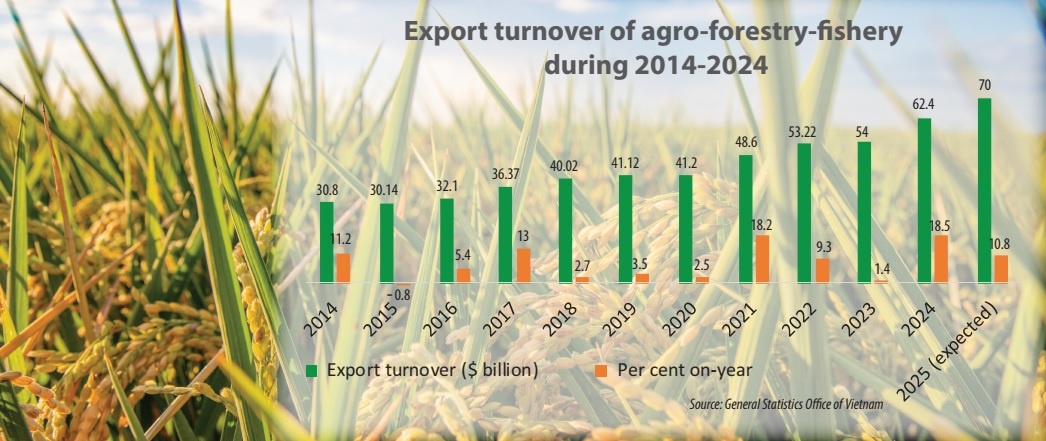Agricultural sector can thrive on back of big 2024
The export turnover of the fishing and farming sector is forecast to have reached $62.4 billion for the whole year, an increase of 18.5 per cent compared to the figure for the same period the previous year. Despite the impact of drought and saltwater intrusion, crop productivity remained high, ensuring sufficient output for export.
 |
| Phung Duc Tien, deputy Minister of Agriculture and Rural Development |
The production value reported an increase of 3.2 per cent. Eleven kinds of goods maintained an export turnover of over $1 billion, at which, seven items reported an export value of over $3 billion, including timber and wood products at $16.1 billion, fruit and vegetables $7.1 billion, rice $5.7 billion, coffee $5.4 billion, cashew nuts $4.3 billion, shrimp $3.8 billion, and rubber $3.2 billion.
The agricultural sector’s trade surplus often accounts for 65-72 per cent of the entire economy.
The results are achievements of Vietnam’s objective of producing high-quality agricultural goods with higher added value, enabling participation in global value chains, and developing a national agricultural brand. At the same time, the industry tries to mobilise social resources to invest in agricultural infrastructure, rural regions, and agricultural support services.
At the management level, leaders of the Ministry of Agriculture and Rural Development (MARD) emphasised the importance of issuing directives on slaughter control, veterinary hygiene, and food safety management of animal-origin products. In the cultivation segment, the ministry focuses on directing the production of summer-autumn, autumn-winter, and seasonal rice crops in alignment with weather and market developments.
There was close monitoring of the production of industrial crops and fruit trees, especially key fruit trees such as dragon fruit, longan, durian, mango, and rambutan in the Mekong Delta, to provide crop guidance and increase the percentage of certified products.
To develop the fishery industry, in collaboration with the inspection team of the European Commission, the ministry concentrated on prevention and combat of illegal, unreported, and unregulated fishing. Additionally, measures were implemented to control the trading and transportation of livestock, poultry, and related products, especially at border gates, trails, and openings in border areas.
The entire industry has coordinated with ministries, sectors, and localities to focus on implementing solutions to develop production and respond to market fluctuations, weather conditions, and epidemics. Efforts have also been made in trade promotion and market opening to boost agricultural product consumption.
The ministry was also ready to respond to urgent and unexpected situations. For example, Typhoon Yagi, the biggest in Vietnam in seven decades, caused damage worth nearly $1.3 billion for the agricultural sector alone. It damaged 300,000 hectares of paddy rice, orchards, and vegetable gardens; 5,000 fishery cages; and 167,000 hectares of forest. It also killed four million poultry and 30,000 cattle.
At the time, sectors and localities were directed to overcome the consequences of natural disasters and rebuild production. Implementing this, the entire agricultural sector spread to localities to assess the extent of damage, and find solutions to restore production, prioritise short-term crops, waterfowl, and poultry. It also encouraged localities not affected by storms and floods to accelerate production, and focus on the provinces of the south-central coast and the Mekong Delta to increase aquaculture and increase food sources.
Regarding exports, MARD leaders noted that it was necessary to determine markets and products, and then focus on trade promotion via agricultural counsellors, and ambassadors. In addition, the ministry organised business trips for business delegations to visit production facilities to learn from others.
The ministry focused on expanding export markets, removing barriers, creating better conditions for domestic consumption and supporting enterprises to sign new export orders. It also coordinated to organise conferences at border provinces on trade in agricultural products between Vietnam and China.
For example, in August, the MARD and the General Department of Customs of China signed three key protocols, opening the door for the export of fresh coconuts, frozen durians, and crocodile products to the Chinese market – crucial for Vietnam’s agricultural sector.
In 2025, industry insiders anticipate continued growth, with exports expected to reach new heights. This outlook is fuelled by several factors. Vietnam’s agricultural products are increasingly sought after in international markets due to their high-quality and competitive prices.
The MARD will collaborate with other ministries, including the Ministry of Industry and Trade, to expand its export markets, reducing reliance on traditional buyers and opening up new opportunities for growth. The MARD plans to conduct workshops and training sessions to ensure that all stakeholders, from farmers to exporters, are informed about the new protocols and the necessary compliance measures.
The ministry considers investments in technology and innovation to be crucial factors to enhance productivity and efficiency across the value chain, from production to processing and distribution. Support from the government will strengthen the sector to hit new targets. The government is continuing to support the sector through various initiatives, including infrastructure development, market access facilitation, and financial assistance.
While the exact export turnover figure for 2025 remains to be seen, the MARD is confident that the sector will thrive, driven by these positive factors.
 |
| In 2024, the agricultural sector achieved several notable achievements Record-breaking exports: Vietnam’s agricultural, forestry, and fishery exports reached a record high of $62.4 billion, an 18.5 per cent increase from 2023. Strong growth in major export categories: Every major agricultural export category experienced growth, including timber and wood products, coffee, rice, cashews, pepper, fruit and vegetables. High prices for many products: Many products maintained high prices, yielding significant profits for farmers Favourable conditions for domestic consumption: The domestic market has also seen favourable conditions for agricultural consumption, with minimal instances of “bumper harvest, low prices”. Many products have consistently maintained high prices, significant profits for farmers. Vietnam’s 100-million-strong population offers significant potential for agricultural consumption. Increasing consumer preference for Vietnamese products is helping diversify distribution channels for staple goods like rice, fruits, and seafood. |
What the stars mean:
★ Poor ★ ★ Promising ★★★ Good ★★★★ Very good ★★★★★ Exceptional
Related Contents
Latest News
More News
- Pivotal stage of growth paves way for rise in M&As (December 03, 2025 | 10:00)
- Positive projections for M&A interest from Thailand (December 03, 2025 | 09:40)
- Manifesting the first line of defence in cybersecurity (December 03, 2025 | 09:00)
- The transformational role AI can play in accounting arena (December 03, 2025 | 08:00)
- Unlocking 5G-AI potential in Singapore (December 03, 2025 | 08:00)
- Data-driven strategies vital for a fast-evolving nation (December 02, 2025 | 09:41)
- Policy to practice: how Vietnam can lead the region (November 26, 2025 | 16:03)
- Mobilising private capital at scale vital for climate battle (November 26, 2025 | 15:36)
- VILAF and Yoon & Yang launch Vietnam - Korea Practice Unit (November 26, 2025 | 15:16)
- Trademark disputes challenge foreign firms in Vietnam (November 24, 2025 | 15:30)

 Tag:
Tag:






















 Mobile Version
Mobile Version